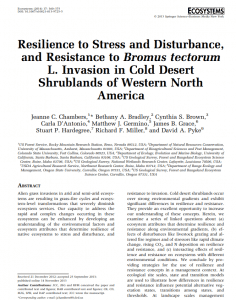Synthesis / Tech Report
View report.
This report, developed by the Western Association of Fish and Wildlife Agencies (WAFWA), Wildfire and Invasive Species Initiative Working Group (Working Group), summarizes the current state of Fire Operations and Fuels management functions in big sagebrush communities. The intent of this report is to illustrate the type and responsiveness of efforts being made. Finally, the report concludes by presenting future options and a series of recommendations that may inform future policy and allocation decisions.
View synthesis.
This synthesis describes what is known about the cumulative impacts of historic livestock grazing patterns and short-term effects of livestock grazing on fuels and fire in sagebrush ecosystems. Over years and decades grazing can alter fuel characteristics of ecosystems. On a yearly basis, grazing can reduce the amount and alter the continuity of fine fuels, potentially changing wildlife fire spread and intensity. However, how grazing-induced fuel alterations affect wildland fire depends on weather conditions and plant community characteristics. As weather conditions become extreme, the influence of grazing on fire behavior is limited, especially in communities dominated by woody plants.
View synthesis.
This review of the literature found that in general long-term rest and modern properly managed grazing produce few significant differences. However, some topic areas have not been adequately studied to accurately predict the influence of long-term rest compared to managed grazing. In some situations, not grazing can cause an accumulation of fine fuels that increase fire risk and severity and, subsequently, the probability of sagebrush steppe rangelands converting to exotic annual grasslands. Shifts in plant communities (i.e., exotic annual grass invasion and western juniper encroachment), caused in part from historical improper grazing, cannot be reversed by long-term rest.
View report.
This review synthesizes the state of knowledge on fire effects on vegetation and soils in semi-arid ecosystems in the Great Basin Region. It identifies knowledge gaps and presents a framework for predicting plant successional trajectories following wild and prescribed fires and fire surrogate treatments. Possibly the three most important ecological site characteristics that influence a site’s resilience (ability of the ecological site to recover from disturbance) and resistance to invasive species are soil temperature/moisture regimes and the composition and structure of vegetation on the ecological site just prior to the disturbance event.
View review.
This review examines the effects of disturbances, such as grazing, and changes in climate on resilience and resistance of cold desert shrublands that span temperature and precipitation gradients across the western United States. It demonstrates how to use information about cold desert resilience and resistance to help manage this ecosystem and describes the benefits of using protection, prevention, restoration, and monitoring strategies to determine priority management areas and appropriate management actions.
View report.
This report synthesizes current information on the effectiveness of post-fire seeding for both soil stabilization and for prevention of the spread of invasive species in rangelands. This information will help federal land managers make more cost-effective decisions on post-fire stabilization and rehabilitation treatments.
View report.
This study was designed to improve the understanding of both individual and community actions that homeowners currently do or might take to protect their home or property, and the barriers that impede homeowners from completing firewise treatments to their home or property.
View review.
This review summarizes fire use in the forests and woodlands of North America and the current state of the practice, and explores challenges associated with the use of prescribed fire. Although new scientific knowledge has reduced barriers to prescribed burning, societal aversion to risk often trumps known, long-term ecological benefits. Broader implementation of prescribed burning and strategic management of wildfires in fire-dependent ecosystems will require improved integration of science, policy, and management, and greater societal acceptance through education and public involvement in land-management issues.
View report.
The key findings of this synthesis are organized along nine topical areas: types of crown fires; crown fire initiation; crown fire propagation; crown fire rate of spread; crown fire intensity and flame zone characteristics; crown fire area and perimeter growth; crown fire spotting activity; models, systems, and other decision aids for predicting crown fire behavior; and implications for fire and fuel management.
View report.
In this literature synthesis and meta-analysis, researchers found that the overall mean effect of fuel treatments on fire responses is large and significant, equating to a reduction in canopy volume scorch from 100% in an untreated stand to 40% in a treated stand, a reduction in scorch height from 30.5 m to 16.1 m, or an inferred reduction in flame length from 3.4 m to 2.1 m. But our synthesis demonstrates that fuel treatments vary widely in effectiveness, which is largely explained by vegetation and treatment type.


